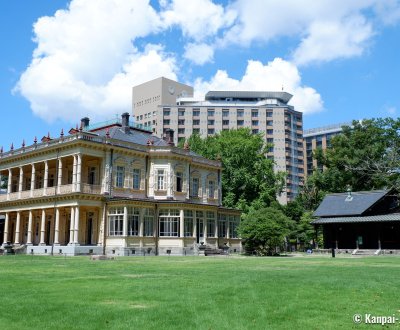Kyu Iwasaki-tei Teien
Meiji Era Garden in Tokyo
Kyu Iwasaki-tei Teien is the former property of the Iwasaki family, encompassing both a Western-style and a Japanese-style garden, located in the west of Ueno, in the north of Tokyo. Showing typical trademarks of Meiji Era modernizing Japan, the site features 3 residences displaying an architecture of their time as well as a lawn garden.
Kyu Iwasaki-tei Teien, one of the 9 historical gardens managed by the Tokyo Metropolitan Government, is a testimony of Japanese architecture and landscaping styles of the Meiji Era (1868 – 1912), a time of restoration of the Emperor’s power while the country opened to the West and its industry subsequently modernized.
The estate was originally part of a feudal property perched on the heights of the Japanese capital, newly established under the Tokugawa shogunate, and belonged to several successive lords during the Edo period (1603 - 1868) before falling into the ownership of the Iwasaki family. Iwasaki Yataro (1835 – 1885), also owner of the Kiyosumi Teien and Rikugi-en gardens, founded the Mitsubishi Group in 1870.
In 1896, Kyu Iwasaki-tei Teien became the new main residence of Iwasaki Hisaya (1865 – 1955), Yataro’s eldest son and 3rd historical president of Mitsubishi. The estate then extended on a 4,9 hectares superficies, with about 20 constructions mixing various architectural styles.
Requisitioned at the end of World War II, the former Iwasaki Clan Residence was passed on to the Japanese State that used it for its administration. In 2001, the Tokyo Metropolitan Government becomes the new operator of the site and opens it to the public. Nowadays, only a third of what used to be the Iwasaki Estate remains and is accessible to visitors, namely a 1,7 hectares superficies including 3 buildings and 2 different green spaces.

3 period buildings to visit
The Western-style house is the main construction of the garden in a European-style, designed by British architect Josiah Conder (1852 - 1920), also known as the "father of Japanese modern architecture," and as the designer of the Rokumeikan Hall in Hibiya district. The building’s style is a reminder of 17th century Jacobean architecture, part of the English Renaissance. The south front displays superimposed colonnade creating a terrace and a large balcony for the upper floor. Inside, several spaces are decorated with period furniture and beautiful preserved wallpaper, some showing embossed ornamentings and gilded leather.
Attached to the Western-style residence that was used as a reception hall, the Japanese pavilion displays a traditional Japanese architecture in the shoin-zukuri style, characteristic of the early Edo period. This house sheltered the Iwasakis’ private living quarters and has had its surface reduced over time due to the construction of tall buildings in its vicinity. Now, only the reception room remains, decorated with a few painted fusuma sliding doors, offering a confidential view on the garden and the 2 other buildings.
The last building is the Billiards Facility, also designed by Josiah Conder, inspired by a Swiss mountain lodge. While the inside of the house is not open to the visit, it is still possible to peek in the room and have a look at its dark wood decoration from the threshold. On a side note, this annex is connected to the Western-style house by an underground tunnel.

The 3 buildings are surrounded by a 2-faceted garden:
• A wood area on the edges of the estate, dating back to the Edo period;
• A lawn garden (called shiba-niwa in Japanese) at the center, that illustrates the evolution of the art of Japanese gardens during the Meiji Era. The garden becomes a simpler, larger and flat lawn, with a winding pathway for strolling and emphasizing the impressive Western-style architecture.
Slightly off the most popular touristic tracks of Tokyo, Kyu Iwasaki-tei Teien doesn’t receive crowds of visitors and can be enjoyed peacefully. Its quietness allows for taking time to snap beautiful pictures and learn more about the historical figures who created the cityscape of the current Japanese capital.

